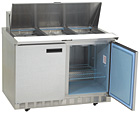
Undercounter refrigeration equipment is getting new controls technology.
One such company involved in the issue is Delfield, which makes reach-in refrigerators and freezers used for the storage of food supplies. All of the equipment is self-contained, meaning that each appliance has a complete refrigeration system with evaporator, compressor, and condenser. Many are front breathing, meaning the air that cools the compressor is drawn in from the bottom front, and the heat removed from the condenser is rejected, or exhausted, there.
In addition, the refrigerators and freezers must perform reliably in a demanding environment. In a fast food restaurant, they stand next to fast food fryers, ovens, broilers, and griddles. The refrigeration appliances are opened and closed hundreds of times each day in a hot and humid restaurant kitchen ambient atmosphere, but they must withstand thermal stress and still maintain steady, healthy temperatures around the clock.
Delfield managers knew they needed to make sure they had tight temperature control in their under-counter line of refrigerators and freezers, at the same time realizing energy savings.
That challenge came into focus with the arrival at Delfield of a new engineering manager who had previously worked at another restaurant appliance maker. He had been involved in the introduction of some new electronic controls and wanted Delfield to look at similar solutions.
ELECTRONIC CONTROL
The new engineering manager had worked with a Danfoss regional sales engineer on a previous project, and made contact with the HVAC and refrigeration components manufacturer concerning the Delfield situation.Danfoss had for some time offered an electronic control for refrigeration appliances, the ETC1H. Because the control is completely electronic, it is able to provide a tight operating band around the set point, according to company officials. The temperature maintained in the appliance cabinet is stable because there is no drift.
But the Delfield prep tables provided a challenge. There were two evaporators in each cabinet, and the control’s standard software was engineered for single evaporators. Both companies were hopeful that the solution for better temperature control could be found.
What was proposed was that a special version of software be written for the Delfield solution. Dual-evaporator routines were added to the control, as well as other functions.
Those involved in the project said that when the new controls were used, they achieved positive results. In addition, applications of new defrost routines, a small compressor, redesigned evaporator, and optimized airflow yielded energy savings on the order of 30 percent.
One of the features of the ETC1H is its ability to communicate with a Danfoss control system. Engineers developed a PC-based software tool that links with the ETC1H to bring information to the user for performance analysis. Users can see the status of sensor inputs and relay outputs, as well as perform testing and troubleshooting.

Pictured is the Danfoss ETC1H electronic control, which is able to provide a tight operating band around the set point. (Photo courtesy of Danfoss.)
ENERGY EFFICIENCY
Those involved cited several factors resulting in the energy savings:• There is less compressor run time because of fan control.
• Fan startup is delayed after defrost to allow all water to drip from the evaporator. This means that when the compressor is turned on, there is no water to freeze on the evaporator and hasten the need for the next defrost.
• Defrosts are started and stopped by logic. Because the control incorporates timers, and since the compressor runs on demand when cabinet temperature rises, a defrost can be initiated after a certain compressor run time. But the controller offers another approach as well.
When an evaporator needs defrost, it is covered with ice. That makes it inefficient at cooling because the ice insulates the evaporator. So the new controller can be programmed to start defrost based on compressor run time or on high evaporator temperature. In this strategy, defrost is terminated not after a certain time, but when evaporator temperature reaches the level at which all ice is melted.
Product integrity is said to be improved by using temperature termination of defrost rather than relying on a timer or thermostat.
In a traditional refrigeration appliance, fans run constantly. In the new approach, the control’s intelligent software and multiple control outputs can turn the fan off when the compressor is not running. Not only is the energy required to run the fan saved, but also the energy required to remove the heat blown into the cabinet by the fan bringing in ambient air while the compressor is off.
COUNTING SAVINGS
Maintenance savings are hard to quantify, but the ETC1H was said to also protect the compressor from over- or under-voltage, an important feature where main power varies, and particularly important in areas subject to brownouts.Alarms are activated or error codes are displayed when established parameters are exceeded. Each alarm can be associated with a time delay. So, for instance, a high temperature alarm will not be generated until temperature has been above the danger level for a user-defined time.
Because of the positive results with the under-counter equipment, Delfield has begun using the ETC1H digital display and alarms for its larger reach-in refrigerators and freezers.
More information on the project can be obtained at www.danfoss.us.com or www.delfield.com.
Publication Date:04/07/2008

Report Abusive Comment